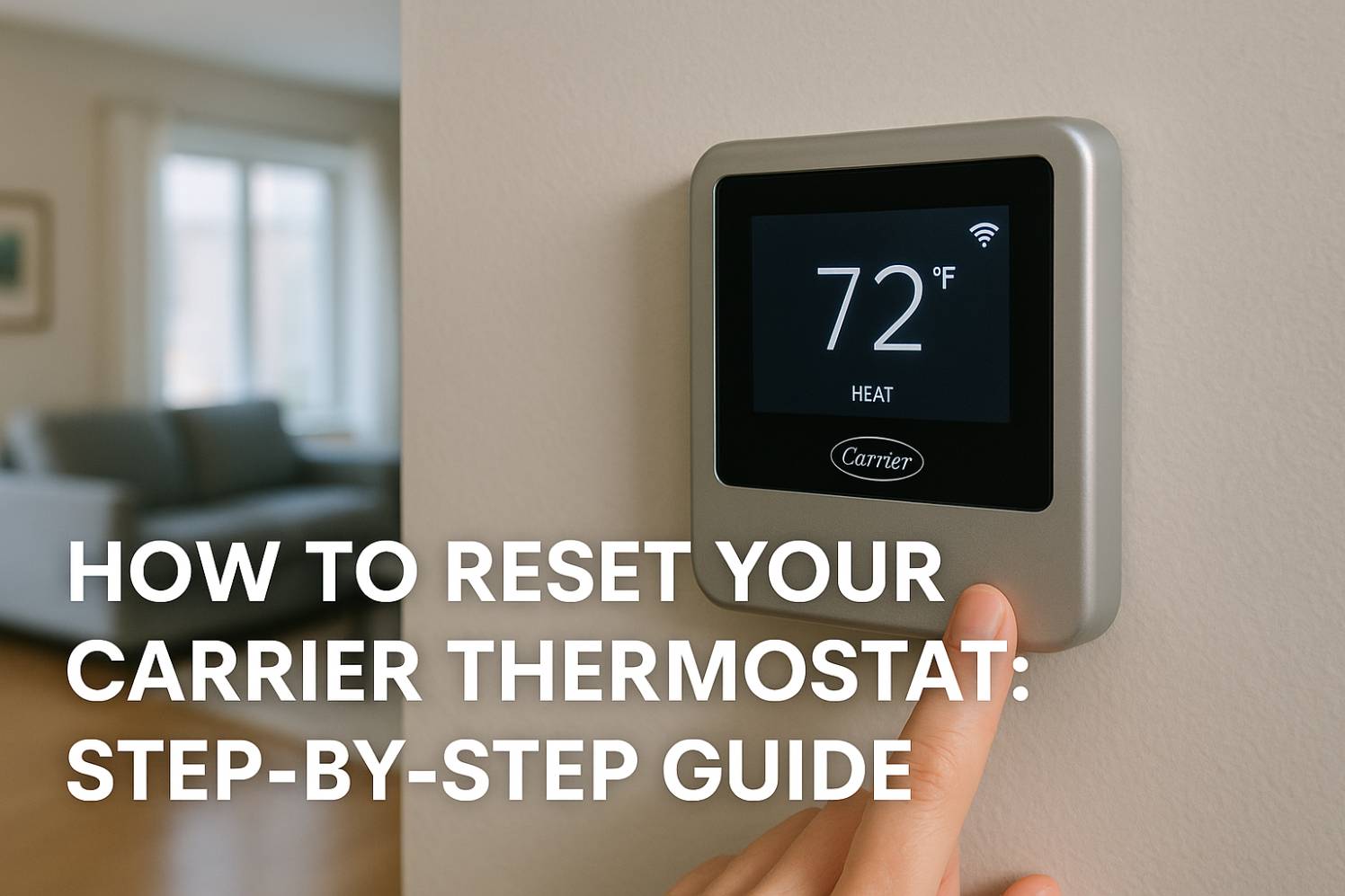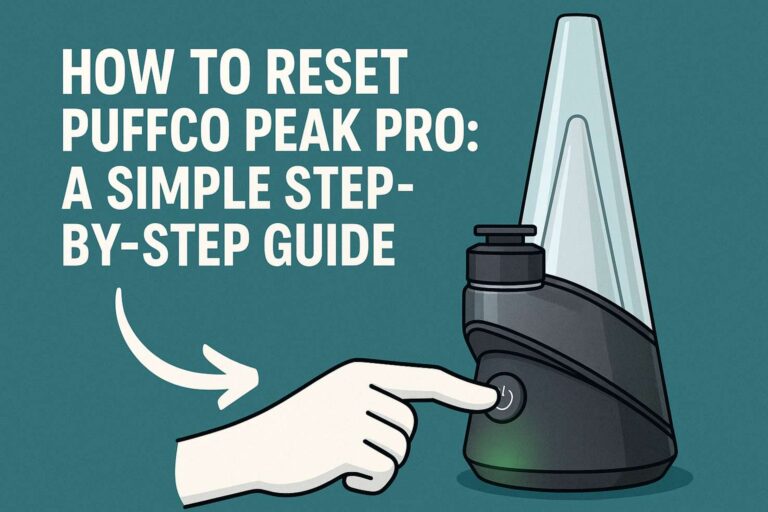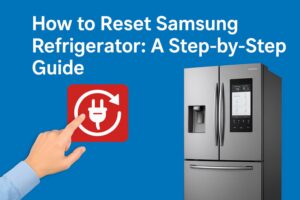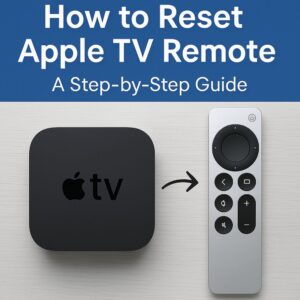Have you ever found yourself frustrated with your Carrier thermostat, unable to get it to work properly? It’s a common issue many homeowners face, but don’t worry—resetting your Carrier thermostat can often solve the problem.
Whether your thermostat is unresponsive, displaying incorrect temperatures, or just not working as it should, knowing how to reset your Carrier thermostat can save you time, money, and stress.
In this guide, I’ll walk you through the simple steps to reset your thermostat and troubleshoot any issues that may arise along the way.
Understanding Your Carrier Thermostat
Before diving into the reset process, it’s essential to understand the type of Carrier thermostat you have. Carrier offers a variety of models, including manual, digital, and smart thermostats. Each type may have slightly different reset instructions.
Types of Carrier Thermostats:
- Manual Thermostats: These models are simple and use physical dials or sliders to adjust the temperature. They require a manual reset if the settings are incorrect or if there is a system error.
- Digital Thermostats: These models feature a digital interface but still rely on buttons or touchscreens for control. They may need a reset if the display freezes or if the system malfunctions.
- Smart Thermostats (Wi-Fi Enabled): Carrier’s smart thermostats allow you to control your heating and cooling system remotely via an app or through voice commands with devices like Google Home or Amazon Alexa. Resetting a smart thermostat may involve using the mobile app or accessing the device’s settings.
Step-by-Step Guide to Resetting Your Carrier Thermostat
Resetting your Carrier thermostat can be a quick fix for many common issues. Let’s walk through the process for both manual and smart thermostats.
How to Reset Your Carrier Thermostat Manually
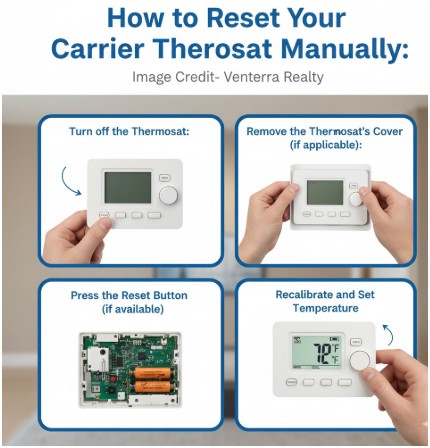
- Turn off the Thermostat: Begin by turning off the thermostat using the power button or dial.
- Remove the Thermostat’s Cover (if applicable): Some manual models require you to remove the thermostat cover to access the internal components.
- Press the Reset Button (if available): Many Carrier manual models have a small reset button located near the batteries or on the thermostat’s side. Press and hold this button for a few seconds until the screen goes blank and then restarts.
- Recalibrate and Set Temperature: Once the thermostat resets, adjust the temperature settings to your desired level.
How to Reset a Digital Carrier Thermostat
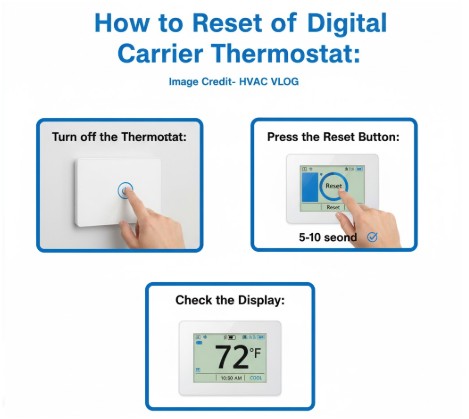
- Turn off the Thermostat: Press the power button to turn off the thermostat.
- Press the Reset Button: On most digital Carrier thermostats, you’ll find a reset button or option in the menu. Press and hold the reset button for 5-10 seconds until the thermostat restarts.
- Check the Display: After resetting, check the display to ensure it’s showing the correct time and temperature settings. If the display still isn’t functioning correctly, try adjusting the settings manually.
How to Reset a Smart Carrier Thermostat:
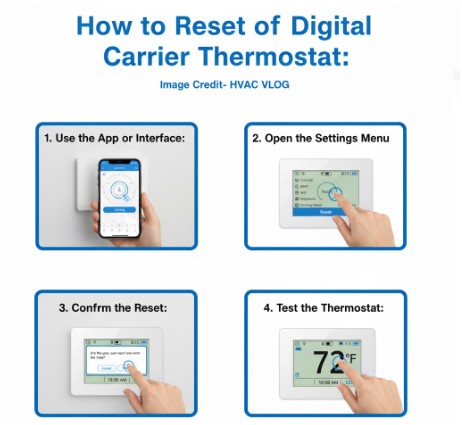
- Use the App or Interface: For Wi-Fi-enabled Carrier thermostats, the reset process may vary depending on the model. Typically, you can access the reset option directly through the thermostat’s mobile app or via the thermostat’s main screen.
- Open the Settings Menu: Navigate to the settings menu on the app or thermostat screen and select the “Reset” or “Factory Reset” option.
- Confirm the Reset: Once you confirm the reset, the thermostat will return to its default settings. You may need to reconnect it to your Wi-Fi and re-enter your preferences.
- Test the Thermostat: After resetting, check if the thermostat is functioning properly. Ensure it’s connected to Wi-Fi, and the settings reflect your preferences.
Common Carrier Thermostat Issues That May Require a Reset
There are several common issues that can be solved by resetting your Carrier thermostat:
- Unresponsive Thermostat: If the thermostat isn’t responding to commands or the touchscreen is frozen, a reset can often fix the issue.
- Incorrect Temperature Readings: If the temperature displayed on your thermostat doesn’t match the actual room temperature, resetting it can help recalibrate the device.
- No Heating or Cooling Response: When the system isn’t heating or cooling as expected, resetting the thermostat can help restore normal operation.
- Wi-Fi Connection Issues: For smart thermostats, resetting can resolve connectivity problems if your thermostat is having trouble connecting to your Wi-Fi network.
Troubleshooting Carrier Thermostat Problems
If your Carrier thermostat doesn’t work correctly after resetting it, there could be several other factors at play. Here are some additional troubleshooting steps to try:
- Check the Power Supply: Make sure the thermostat has a reliable power source. For battery-operated models, replace the batteries.
- Ensure Proper Wiring: If the thermostat is wired incorrectly, it may not work properly. Check the wiring connections and make sure everything is secure.
- Look for Error Codes: Some Carrier thermostats display error codes. Refer to the thermostat’s manual for troubleshooting tips specific to the error code.
- Clean the Thermostat: Dust or debris can interfere with your thermostat’s functionality. Clean the thermostat’s surface and display regularly.
When to Seek Professional Help
If your Carrier thermostat continues to malfunction after performing a reset and troubleshooting, it may be time to contact a professional HVAC technician. Here are some signs it’s time to call for expert help:
- Constant Temperature Fluctuations: If your thermostat continues to show incorrect readings despite resetting and recalibrating, there may be a deeper issue.
- System Short Cycling: If the HVAC system turns on and off frequently, it could be a sign of a malfunctioning thermostat or HVAC system.
- Wiring Issues: If the thermostat is wired incorrectly or damaged, it could lead to electrical problems or malfunction.
Maintenance Tips for Your Carrier Thermostat
Keeping your Carrier thermostat in good working condition requires regular maintenance. Here are a few tips:
- Replace the Batteries (for Manual Models): If your thermostat is battery-operated, replace the batteries every six months to prevent malfunctions.
- Clean the Thermostat Regularly: Dust and dirt can affect the performance of your thermostat. Clean it with a dry cloth regularly.
- Recalibrate the Thermostat: Over time, your thermostat may need recalibration. Follow the manual’s instructions for recalibrating the device.
FAQ Section
How to reset Carrier control board?
To reset the Carrier control board, follow these steps:
- Turn off the Power: Begin by turning off the power to your HVAC system at the breaker box.
- Wait for 1-2 Minutes: Allow the system to power down completely.
- Turn the Power Back On: Switch the breaker back on to restore power to the unit.
- Reset the Control Board: If your unit has a reset button on the control board, press and hold it for a few seconds. Alternatively, simply power cycling the system can reset the control board.
- Test the System: Once the reset is complete, check your thermostat to see if it’s responding correctly and controlling the system as expected.
Why is my Carrier thermostat not working?
There could be several reasons why your Carrier thermostat is not working. Here are some common causes:
- Power Supply Issues: Ensure that the thermostat is properly powered. For battery-operated models, replace the batteries. For wired models, check the power supply and ensure there’s no electrical interruption.
- Loose or Disconnected Wiring: If the thermostat isn’t receiving a proper signal, check the wiring connections on both the thermostat and the control board.
- Thermostat Calibration Problems: Sometimes, the thermostat may need recalibration if it’s reading incorrect temperatures. Try resetting it to see if the issue resolves.
- System Malfunction: Your HVAC system might be the source of the problem. If the thermostat isn’t responding, it could indicate a larger issue with the heating or cooling system.
- Blown Fuse or Tripped Circuit: A blown fuse or tripped circuit could disrupt the operation of your thermostat. Check the fuses or breakers to make sure they haven’t been triggered.
- Outdated Software (for Smart Thermostats): For Wi-Fi-enabled models, outdated software or firmware may cause functionality issues. Make sure your thermostat’s software is up-to-date.
If none of these solutions work, it’s best to contact a professional HVAC technician to diagnose and repair the issue.
Conclusion
Resetting your Carrier thermostat is a simple yet effective way to resolve many common issues. Whether you’re working with a manual, digital, or smart model, the steps outlined above should help you get your thermostat back in working order.
Regular maintenance and troubleshooting can also extend the life of your thermostat, ensuring you stay comfortable year-round.
If you’re still having issues, don’t hesitate to seek professional help. After all, keeping your HVAC system running smoothly is the key to comfort in your home.




